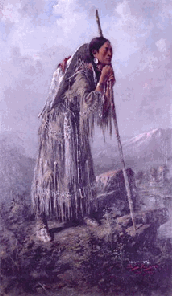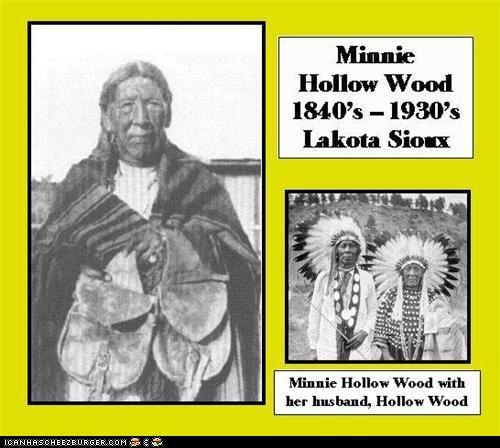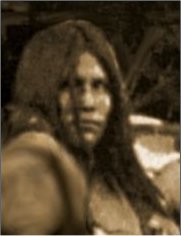Edited by Roy Cook
American Indians have participated with distinction in United States military actions for more than 200 years. Sadly, very little is known about the contributions of Native American women to the United States military.
Historians have only recently rediscovered and verified the actions of an Oneida woman, Tyonajanegen, an Oneida woman who fought on the side of the United States at the Battle of Oriskany, in New York, in 1777. A bloody, six hour enemy engagement, Tyonajanegen fought by her husband’s side on horseback. When her husband became wounded in the wrist she continued to reload his gun so he might continue to fight. Tyonajanegen, also armed with a pistol, used her weapon against the enemy.
 The
story of Sacajawea, the Shoshone woman who kept the Lewis and Clark expedition
of November 1804 is well known. She helped save the expedition several
times from starvation, disaster and mis-direction thanks to her negotiating
skills, knowledge in medicinal herbs and knowledge of the terrain. Much
of what is common knowledge is romantic history, however. Sacajawea is
best remembered as a guide across the Northern Plains. Her people, the
Lemhi Shoshone, or Snake People, spent much of the year traveling in small
groups. From about 1700, the Shoshone had horses, probably pintos and
Appaloosas acquired from the Nez Perce. In the fall of 1800, when Sacagawea
was around 10 years old, her group was camped near the three forks of
the Missouri River. Suddenly, a band of Hidatsa (also called Minataree)
attacked. The Shoshone bows and arrows were useless against the Hidatsa's
rifles. Sacagawea and others were captured and taken back to the Hidatsa
villages near present-day Stanton, North Dakota.
The
story of Sacajawea, the Shoshone woman who kept the Lewis and Clark expedition
of November 1804 is well known. She helped save the expedition several
times from starvation, disaster and mis-direction thanks to her negotiating
skills, knowledge in medicinal herbs and knowledge of the terrain. Much
of what is common knowledge is romantic history, however. Sacajawea is
best remembered as a guide across the Northern Plains. Her people, the
Lemhi Shoshone, or Snake People, spent much of the year traveling in small
groups. From about 1700, the Shoshone had horses, probably pintos and
Appaloosas acquired from the Nez Perce. In the fall of 1800, when Sacagawea
was around 10 years old, her group was camped near the three forks of
the Missouri River. Suddenly, a band of Hidatsa (also called Minataree)
attacked. The Shoshone bows and arrows were useless against the Hidatsa's
rifles. Sacagawea and others were captured and taken back to the Hidatsa
villages near present-day Stanton, North Dakota.
In historical reality, she served as an interpreter for members of the intelligence gathering expedition. In command but they were unfamiliar with any Indian languages. "Bird Woman's" service is described in the journals kept by Army Captains Meriwether Lewis and William Clark during the Military expedition in preparation for the future ‘manifest destiny’ invasion.
In her book, Life Among the Paiutes, Sarah Winnemucca, describes how the women of her tribe took part in war, giving, as an example, her sister-in-law.
“One splendid woman that my brother Lee married after his first wife died, went out into the battle-field after her uncle was killed, and went into the front ranks and cheered the men on. Her uncle’s horse was dressed in a splendid robe made of eagles’ feathers and she snatched it off and swung it in the face of the enemy, “… and she said she took her uncle’s place, as brave as any of the men.”
Minnie Hollow Wood, Sioux and is said to be at one time the only woman of her tribe so entitled to wear a Eagle feather bonnet. This came from taking part in combat against the U.S. Calvary at the Little Big Horn battle.
Minnie
Hollow Wood and husband Hollow Wood, 1927 image
Arizona Oodham Military Service:
From earliest European contact the Oodham have always been described as generous people. They sheltered the Pee Posh (or Maricopa Indians) who fled attack by hostile tribes, and who also became part of the Gila River community. Anyone who followed west along the Gila River, the main southern route to the Pacific, encountered these peaceful and productive traders who gave hospitality to travelers for hundreds of years. "Bread is to eat, not to sell. Take what you want," they told Kit Carson in 1846.
 One
of the first accurate accounts of an Indian and American military alliance
is recounted in the Pima calendar sticks which relate that the Pima and
Maricopa joined with white soldiers in a campaign against the Apaches
under White Hat, in 1856 or 1857. As long as whites were just passing
through, the protection (Pima and Maricopa) provided for their supply
trains was sufficient. Pima and Maricopa fulfilled this need with regular
punitive raids against the Apaches several times a year, keeping them
away from Pima lands but stopping short of attacking their enemies' mountain
rancherías (village-camps). The Oodham warriors were there to defend
the people when the US military left Arizona in 1861 to fight in the US
civil war. The Oodham (Pima) were the only armed force to defend the peaceful
settlements from the Apache raids in the Arizona territory.
One
of the first accurate accounts of an Indian and American military alliance
is recounted in the Pima calendar sticks which relate that the Pima and
Maricopa joined with white soldiers in a campaign against the Apaches
under White Hat, in 1856 or 1857. As long as whites were just passing
through, the protection (Pima and Maricopa) provided for their supply
trains was sufficient. Pima and Maricopa fulfilled this need with regular
punitive raids against the Apaches several times a year, keeping them
away from Pima lands but stopping short of attacking their enemies' mountain
rancherías (village-camps). The Oodham warriors were there to defend
the people when the US military left Arizona in 1861 to fight in the US
civil war. The Oodham (Pima) were the only armed force to defend the peaceful
settlements from the Apache raids in the Arizona territory.
In 1865 and 1866, Pima and Maricopa and Hispanic soldiers served in the first USA Arizona Volunteer Infantry. Arizona Governor Goodwin appointed Thomas Ewing, a teamster from the Pima Villages, to recruit Maricopa Indians, and former sergeant John D. Walker to recruit the Pima.
Apache Women Warriors:
 The
most gifted and least known Indian woman warrior was Lozen, Warm Springs
Apache, who fought with her famous brother Victorio. Lozen chose the path
of a warrior – a choice respected by her people. Lozen had the gift
of discerning the location of the enemy and, it has been said, that if
she had been with Victorio when his band was ambushed by the Mexican army
he would not have been killed. One story that demonstrates her bravery
tells of her crawling into a line of fire to get a bag of bullets desperately
needed by the poorly armed Apaches. Lozen later joined Geronimo, who would
eventually choose her as a messenger to arrange the meeting with the American
military when he finally surrendered. Lozen was the other war woman who
eventually rode with Geronimo and, with Dahteste, convinced him to surrender
to the white military in 1886.
The
most gifted and least known Indian woman warrior was Lozen, Warm Springs
Apache, who fought with her famous brother Victorio. Lozen chose the path
of a warrior – a choice respected by her people. Lozen had the gift
of discerning the location of the enemy and, it has been said, that if
she had been with Victorio when his band was ambushed by the Mexican army
he would not have been killed. One story that demonstrates her bravery
tells of her crawling into a line of fire to get a bag of bullets desperately
needed by the poorly armed Apaches. Lozen later joined Geronimo, who would
eventually choose her as a messenger to arrange the meeting with the American
military when he finally surrendered. Lozen was the other war woman who
eventually rode with Geronimo and, with Dahteste, convinced him to surrender
to the white military in 1886.
She was also taken to the prison in Florida, and later was transported to Mount Vernon Barracks in Alabama. Lozen died there, presumably of tuberculosis, at the approximate age of 50.